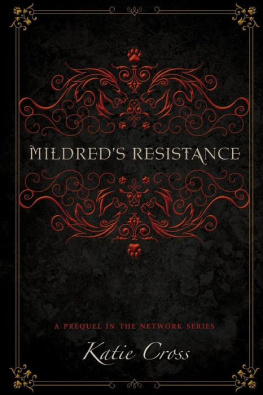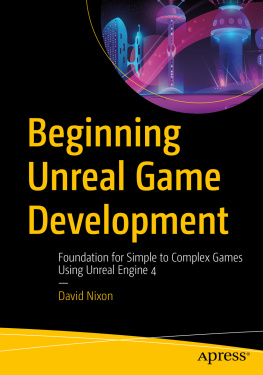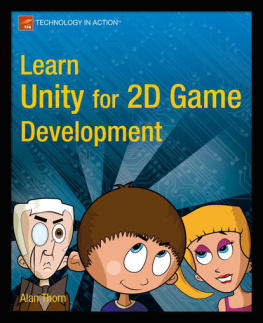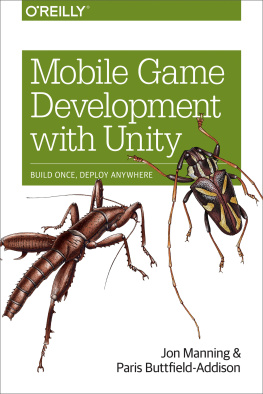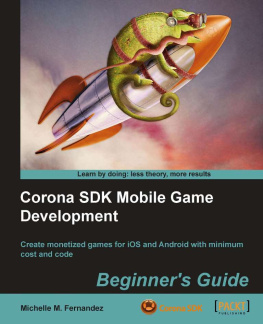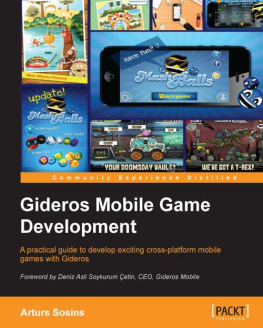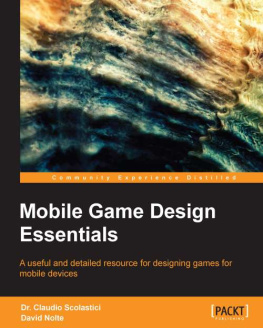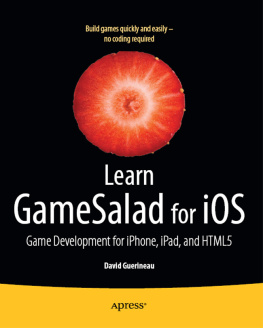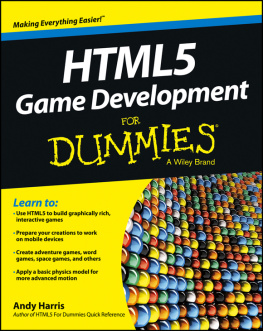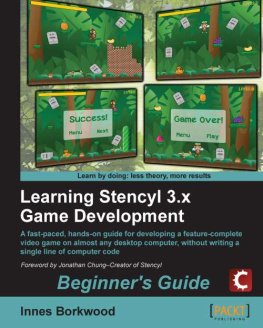Contents
Learn Mobile Game Development in One Day Using Gamesalad
Create Games for iOS, Android, and Windows Phones and Tablets
Copyright 2015 Jamie Cross
All right reserved. No part of this book may be reproduced, stored in a retrieval system, or transmitted by any means, electronic, mechanical, photocopying, recording, or otherwise, without written permission from the author. No patent liability is assumed with respect to the use of the information contained herein. Although every precaution has been taken in the preparation of this book, the publisher and author assume no responsibility for errors or omissions. Nor is any liability assumed for damages resulting from the use of the information contained herein.
Trademarks
Trademarked names, logos, and images may appear in this book. Rather than use a trademark symbol with every occupance of a trademarked name, logo, or image the author used the names, logos, and images only in a editorial fashion and to the benefit of the trademark owner, with no intention of infringement of the trademark.
The use in this book of trade name, trademarks, service marks, and similar terms, even if they are not identified as such, is not to be taken as an expression of opinion as to whether or not they are subject to proprietary rights.
Gamesalad is a trademark of Gamesalad Inc.
Mackintosh is a trademark of Apple, Inc.
Windows is a trademark of Microsoft Corp.
All other trademarks are the property of their respective owners.
Credits
Some assets used in the creation of some of the games within this book are used under creative commons license or have been placed in the public domain.
Artwork by MillionthVector ( millionthvector.blogspot.com ) is licensed under a Creative Commons Attribution 4.0 International License.
Artwork by Kenney ( Kenney.nl ) is placed in the public domain.
Artwork from Glitch ( glitchthegame.com ) is placed in the public domain.
Preface
This book has been written so readers will get up to speed and quickly learn how to work with Gamesalad to quickly and easily develop 2D mobile video games. Readers will not only learn how to create four specific game types, but will learn about game development in general. In addition to creating four different games, while working through the exercises in this book, readers will not only learn how to use Gamesalad, but will be taught why things work the way they do. When you have finished reading this book, you will have a solid understanding of game development using Gamesalad and have four mobile-ready games to publish.
Who Should Read This Book
This book is for anyone who wants to learn how to create their own video games for desktop and mobile devices using Gamesalad. While this is an introductory book that assumes you have no previous game development experience, youll find that once you have completed all of the chapters and exercises, youll be able to create your own amazing video games from scratch.
Overview of Chapters
This book is written in a series of 24 chapters representing the 24 hours in one day. Each chapter should take approximately an hour to complete.
Chapter 1: Introduction to Game Development with GamesaladThis chapter will introduce you to game development and show you how to download and install Gamesalad.
Chapter 2: The Scenes Tab and The StageIn this chapter, you will learn about the stage and how to add scenes to a game.
Chapter 3: Game Objects and Gamesalads Coordinate SystemThis chapter will teach you about Gamesalads coordinate system and introduce you to actors, one of the main components of Gamesalad.
Chapter 4: Actors and Their AttributesYou will learn more details about actors and how to create, set up, and use them in a game.
Chapter 5: Game 1Pachinko/PlinkoIts time for your first game. In this chapter, youll use what youve learned to create one of the most popular games in the world!
Chapter 6: AttributesIn this chapter, youll be introduced to attributes, Gamesalads way of dealing with variables. Youll not only learn how to use Gamesalads built-in attributes, but learn how to create and manipulate your own custom attributes.
Chapter 7: Graphics and ArtworkThis chapter will teach you all about creating graphics for use in Gamesalad. Youll learn what file types to use, how to create your art at the correct size, and how to create a transparent background for sprites.
Chapter 8: Behaviors Part 1In chapter 8, youll be introduced to behaviors, Gamesalads drag and drop coding language. Youll learn the basics of using behaviors and see just how easy it is to create your own custom games.
Chapter 9: Behaviors Part 2This chapter continues the discussion about behaviors by focusing on some of the special behaviors Gamesalad offers.
Chapter 10: Player InputYoull learn several ways to accept input from the player in chapter 10, from creating keyboard controls to accepting touch input on mobile devices.
Chapter 11: Game 2Space ShooterFor the second game, youll create a classic 80s style arcade game, pitting the player against an endless onslaught of alien space fighters.
Chapter 12: AudioIn chapter 12, you will learn how to add and use music and sound effects in your Gamesalad projects.
Chapter 13: The Expression EditorThis chapter will teach you the ins and outs of the expression editor, Gamesalads tool for adding formulas to games. Youll learn how to manipulate both mathematic and text formulas using the expression editor.
Chapter 14: Collisions and PhysicsIn this chapter, youll learn how to create collision shapes and how to manipulate the physics settings of each actor so you can create complex actor interactions.
Chapter 15: Camera Control and Graphical User InterfacesChapter 15 will show you how to control the games camera, the players window to your game world, and how to create and set up common graphical user interface (GUI) elements.
Chapter 16: Game 3Box BreakerTime for game 3! In this game, youll use all of the knowledge you have gathered to create a physics-based puzzle game.
Chapter 17: Animation and ParticlesIn chapter 17, youll learn how to animate, in Gamesalad, using frame-based cells and built-in behaviors. Youll also examine how to create spectacular particle effects using the particles behavior.
Chapter 18: TablesThis chapter will teach you all about tables, Gamesalads way of collecting and organizing large amounts of information. You will learn how to create tables, edit them, and recall their data for use by actors.
Chapter 19: Game PolishThis chapter teaches the importance of polishing and play testing your games. It also examines the role a consistent game style plays in development.
Chapter 20: Game 4Geometry RunnerFor your fourth and final game, youll create a pulse pounding, non-stop endless runner style game.
Chapter 21: Mobile DevelopmentChapter 21 will show you how to configure your development environment for mobile games. Youll learn how to play test on mobile devices and learn more details about how to create interactions with mobile games.
Chapter 22: PublishingIn this chapter, you will learn how to use Gamesalads publishing portal to publish games for desktop computers, mobile devices, and even as browser-based HTML 5 games.
Chapter 23: Improving The GamesThis chapter will show you how to make some improvements to the four games you have created throughout the book and prepare them for mobile distribution.
Chapter 24: Review and ResourcesIn this chapter, you will review everything you have learned while reading this book and look at some additional resources you can use to continue with Gamesalad and game development.
Gamesalad Creator Version and Platform
This book was written using the Macintosh version of Gamesalad Creator version number 0.12.10. Gamesalad Creator is available for both the Macintosh and Windows platforms and while the interface on each platform i s somewhat different, they both share the same capabilities and benefits. The screen shots used throughout this book have been taken from the Macintosh version, so the individual screens will look different if you are a Windows user. However, all of the game development concepts remain the same and the same games can be created and played on either platform.




